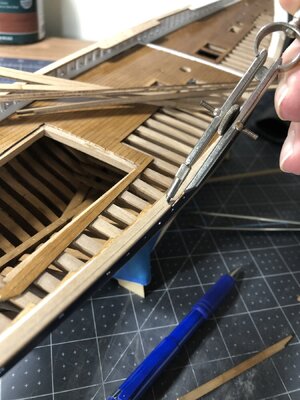This is genius Paul. So simple yet so effective. Thanks for guiding the rest of us.Hello friends!
I learned a few things fabricating the waterway on the lower deck that I was able to apply to the (more complex) waterway of the upper deck. First, I discovered a way to make a quick and accurate pattern... In the image below the cardstock (4 overlapping pieces - one for each of the waterway segments) has only been quickly trimmed to approximate the flow of the inner hull:
View attachment 459224
I then used a washer to trace a precise line...
View attachment 459223
Once I had cut out the cardstock template, I traced that shape onto suitable stock and cut out strips to match. In order to mark the width of the waterway I used a compass:
View attachment 459225
Anyone ever done this???
View attachment 459226
Yes, I am cutting on the wrong side of the line.
Anyway, I then shaped the waterway to the final profile:
View attachment 459227
Fitted and installed:
View attachment 459228
View attachment 459230
Oh, and somewhere along the way I added this iron knee:
View attachment 459229
On the next post you will see the final installation of the bitts...
I have bookmarked this for future reference.
Michael







 (letting them catch all the fish). I have caught enough fish in my life - but to hear "I got one" from someone I love is the best sound ever!
(letting them catch all the fish). I have caught enough fish in my life - but to hear "I got one" from someone I love is the best sound ever!


